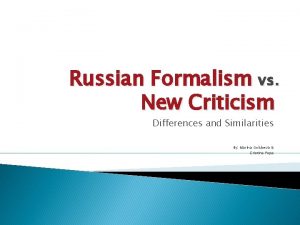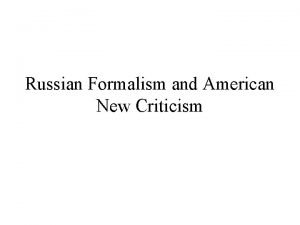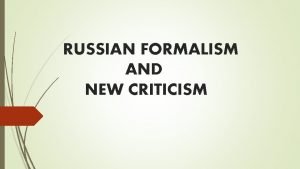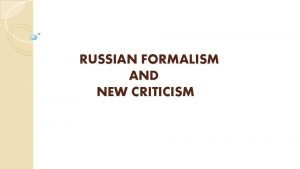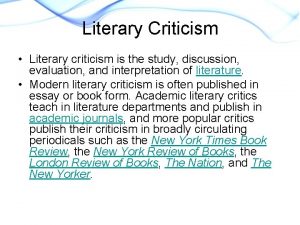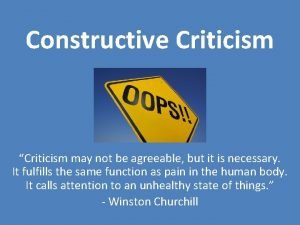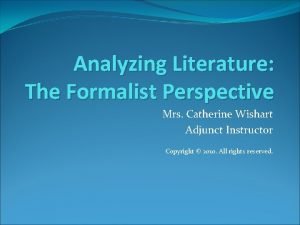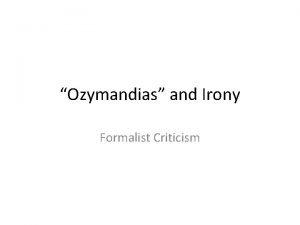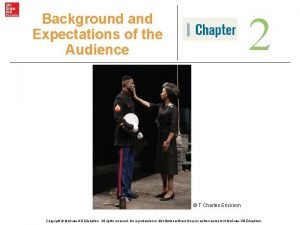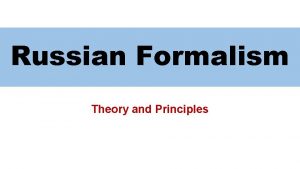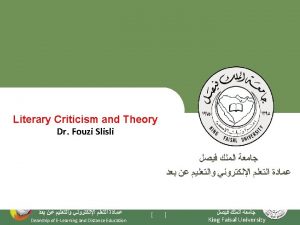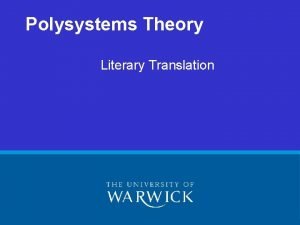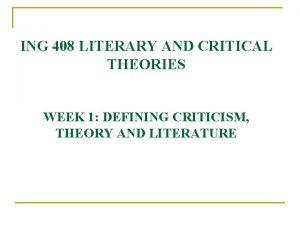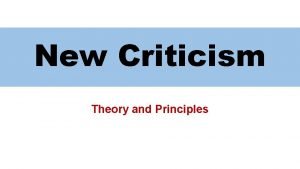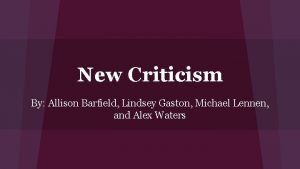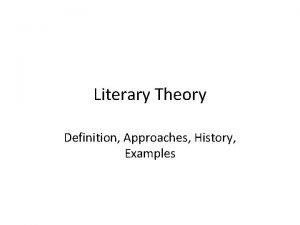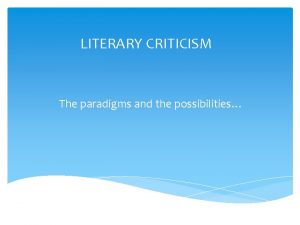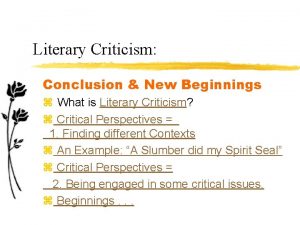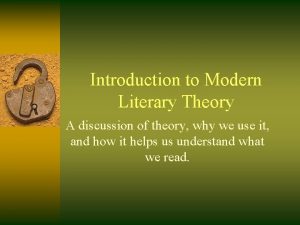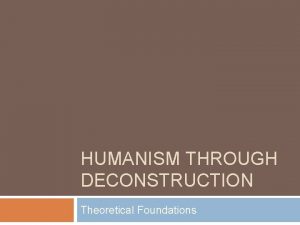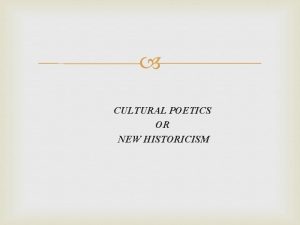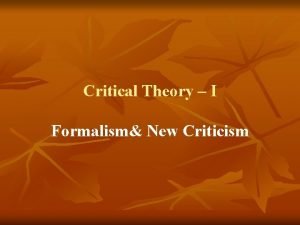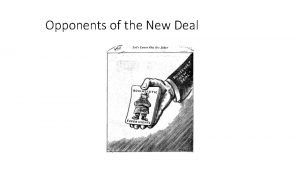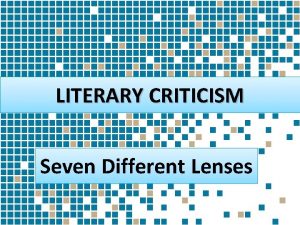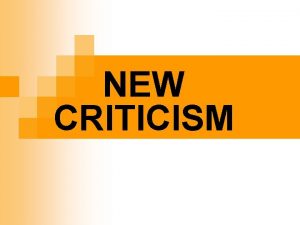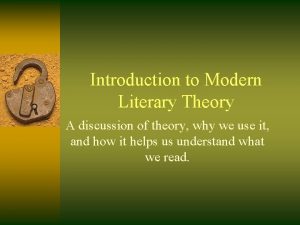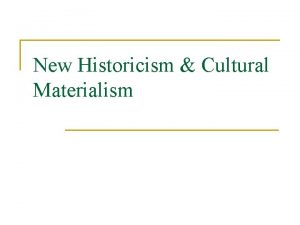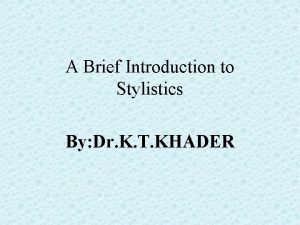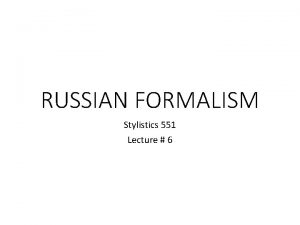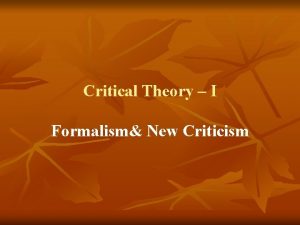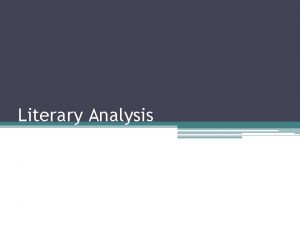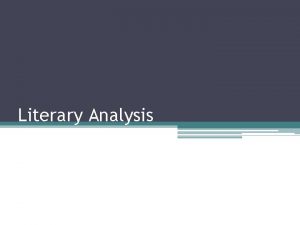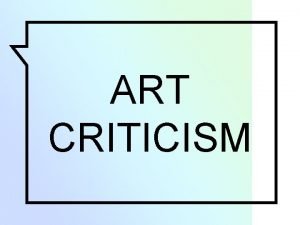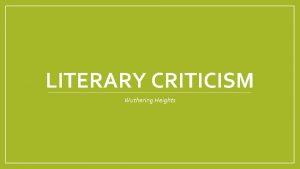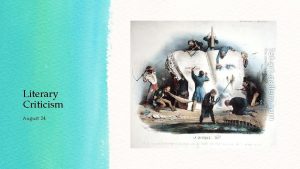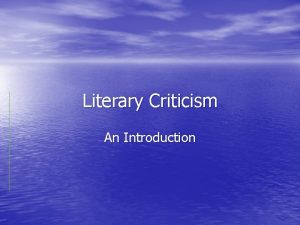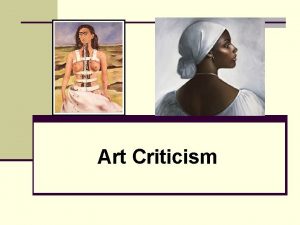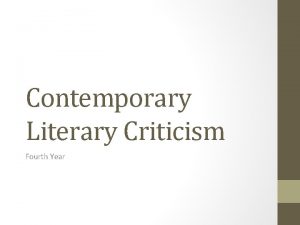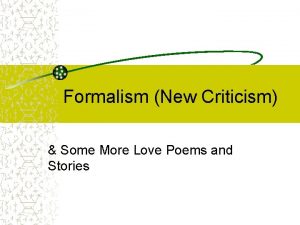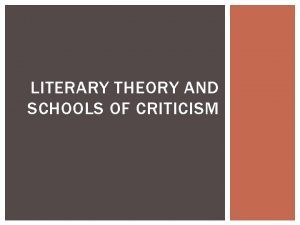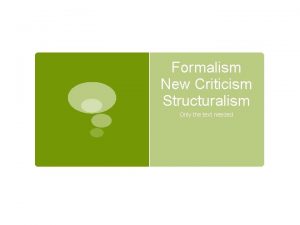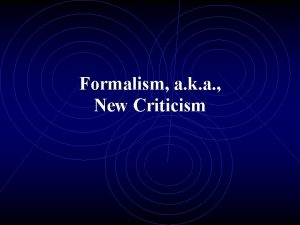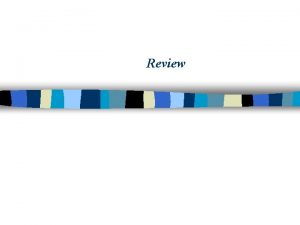RUSSIAN FORMALISM AND NEW CRITICISM RUSSIAN FORMALISM Russian


































- Slides: 34

RUSSIAN FORMALISM AND NEW CRITICISM

RUSSIAN FORMALISM �Russian Formalism is a literary scholarship which originated in the second decade of the twentieth century, and was forcibly supressed in 1930. �The Russian Formalist movement was championed by unorthodox philologists and literary historians, e. g. Victor Shklovsky, Roman Jakobson, Boris Eichenbaum, Boris Tomashevsky and Yuri Tynyanov.

� Its main strongholds were the Moscow Linguistic Circle founded in 1915 and the Petrograd « Society for the Study of Poetic Language» (OPOYAZ) formed in 1916. The initial statement of the Formalist position is found in the symposium, Poetics. Studies in the Theory of Poetic Language (1919), and in Modern Russian Poetry (1921) by Roman Jakobson.

� The driving force behind Formalist theorizing was the desire to bring to an end the methodological confusion which prevailed in traditional literary studies, and to establish literary scholorship as a distinct and integrated field of intellectual endeavor. It is high time, argued the Formalists, that the study of literature limit its area and define its subject of inquiry .

� «The subject of literary scholarship is not literature in its totality but literariness, i. e. , that which makes of a given work a work of literature. » Roman Jakobson � «The literary scholar ought to be concerned solely with the inquiry into distinguishing features of the literary materials. » Boris Eichenbaum

� Literariness : the language used in the text. � According to the Formalists, literary language is different from everyday language.

� The locus of the peculiarly literary was to be sought not in the author’s or reader’s pysche, but in the work itself. � The difference between literature and non-literature had to be sought in the mode of presentation.

� Russian Formalists rejected many nineteenth-century assumptions of textual analysis, especially the belief that a work of literature was the expression of the author’s world view and their dismissal of psychological and biographical criticism as being irrelevant to interpretation. These scholars declared the autonomy of literature and poetic language, advocating a scientific approach to literary interpretation.

� To study literature is to study poetics, which is an analysis of work’s constituent parts – its linguistic and structural features – or its form. Form, they asserted, included the internal mechanics of the work itself, especially its poetic language. These internal mechanics, or what the Formalists called devices, comprise the artfulness and literariness of any given text, not a work’s content.

� Defamiliarization, or making strange, causes the audience to confront the object on a different level, elevating and transforming it from something ordinary or practical into work that is considered art. It means to remove the automatism or perception and the author’s purpose is to create the vision which results from that deautomatized perception.


� By creating the work artistically, its perception is impeded and the greatest possible effect is produced through the slowness of the perception. � I Wandered Lonely as a Cloud That floats on high o’er vales and hills, When all at once I saw a crowd, A host of daffodils; Beside the lake, beneath the trees, Fluttering and dancing in the breeze.

� Animal Farm is an example of defamiliarization in English Literature, because all of the characters are animals. This rescues the work from becoming just another political piece about the evils of Communism and the corruption of power and transforms it into artistic literature. Defamiliarization not only forces the audience to see Animal Farm as art, but allows the author and audience to distance themselves from the seriousness of the message so that the piece can be enjoyed as art and does not become just another political rant.

According to Shklovsky narrative prose has two important aspects: � fabula (story) � syuzhet (plot) Fabula is the raw material of the story and can be considered close to the writer’s working outline. This contains the chronological series of events of the story. The syuzhet is the literary devices the writer uses to transform a story into a plot.

� There is a distinction between the actual sequence of a story’s event as they happen and the way they are presented in the narrative. For example, the fabula is always chronological, moving from beginning to end, whereas the syuzhet may start in the middle (in media res) and then jump back and forth within the chain of events.

� As a group, The Russian Formalists were suppressed and disbanded in 1930 by the Soviet government because they were unwilling to view literature through the Stalinist regime’s political and ideological perspectives. Their influence, however, continued to flourish in Czechoslovakia through the work of Prague Linguistic Circle (founded in 1926, its leading figure being Roman Jakobson) and through the Russian folktale scholar Vladimir Propp.

NEW CRITICISM

� New Criticism provides readers with a formula for arriving at the correct interpretation of a text using only the text itself. � According to New Criticism the poem’s overall meaning or form depends solely on the text. No library research, no studying of the author’s life and times, and no other extratextual information is needed; the poem itself contains all the necessary information to discover its meaning.

� Thanks to the publication of the 1938 college text Understanding Poetry: An Anthology for College Students by Brooks and Warren, New Critcism emerged in American universities as the leading form of textual analysis throughout the late 1930 s until the early 1960 s. � However, its roots stem from two British critics and authors, T. S. Eliot and I. A. Richards. From Eliot, New Criticism borrows its insistence that criticism be directed toward the poem, not the poet. The poet, declares Eliot, does not infuse the poem with his or her personality and emotions, but uses language in such a way as to incorporate within the poem the impersonal feelings and emotions common to all humankind. � Thus, poetry is not freeing of the poet’s emotions, but an escape from them.

� The New Critics also borrow Eliot’s belief that the reader of poetry must be instructed in literary technique. Eliot maintains that a good reader perceives the poem structurally, resulting in good criticism. Such a reader must necessarily be trained in reading good poetry and be well acquainted with established poetic traditions. A poor reader, on the other hand, simply expresses his or her personal emotions and reactions to a text.

Objective Correlative � According to Eliot, the only way of expressing emotion through art is by finding an objective correlative, or a set of objects, a situation, a chain of events, or reactions that can effectively awaken in the reader the emotional response the author desires without being a direct statement of that emotion. � The yellow fog that rubs its back upon the window-panes, The yellow smoke that rubs its muzzle on the window-panes, Licked its tongue into the corners of the evening, Lingered upon the pools that stand in drains, Let fall upon its back the soot that falls from chimneys, Slipped by the terrace, made a sudden leap, And seeing that it was a soft October night, Curled once about the house, and fell asleep. (The Lovesong of Alfred Prufrock by T. S. Eliot)

Close Reading From I. A. Richards, a psychologist and literary critic, New Criticism borrows a term that has become synonymous with its methods of analysis, practical criticism. � In an experiment at Cambridge University, Richards distributed to his students copies of poems minus such information as the authors, dates, spelling and punctuation, and asked them to record their responses. From these data he identified the difficulties that poetry presents to its readers, including matters of interpretation, poetic techniques, and specific meanings. From this analysis, Richards then devised an intricate system for arriving at a poem’s meaning. This close scrutiny or close reading of a text has become synonymous with New Criricism. �

� New Critics assert that a poem has ontological status; that is, it possesses its own being and exists like any other object. � For them, to believe that a poem’s meaning is nothing more than an expression of the private experiences or intentions of its author is to commit a fundamental error of interpretation, which they call the Intentional Fallacy. � Any literary work is a public text that can only be understood by applying the standards of public discourse, not simply the private experience, concerns and vocabulary of its author.

� That the poem is related to author can not be denied. Eliot explains the role of the author with an analogy. He asserts that, certain chemical reactions occur in the presence of a catalyst, an element that causes, but is not affected by the reaction. He gives the example of the hydogen peroxide that stops to be hydrogen peroxide when exposed to sun rays, as sun rays are catalyst that turns it into something different. � So, the poet’s mind serves as a catalyst for the reaction that yields the poem. During the creative process, the poet’s mind, serving as the catalyst, brings together the experiences of the author’s personality (not his personal traits, but rather his personal experiences) into an external object and a new creation: the poem. For Eliot the poet’s experiences are similar to all of our experiences, by structuring these experiences, the poem allows us to examine them objectively.

Affective Fallacy � Placing little emphasis on the author, the social context, or a text’s historical situation as sources for discovering a poem’s meaning, the New Critics assert that a reader’s emotional response to the text is neither important nor equivalent to its interpretation. Such an error in judgement, is called the Affective Fallacy.

Where can we find the poem’s meaning? � As the poem itself is an artifact or an objective entity, its meaning must reside within its own structure. The New Critics assert that a careful scrutiny reveals that a poem’s structure operates according to a complex series of laws. By closely analyzing this structure, they believe they have devised a methodology and a standard of excellence that we can apply to all poems to discover their correct meaning.

What is the chief concern of the poem? � The chief concern of the poem is coherence or interrelatedness. Borrowing their ideas from the writings of Samuel T. Coleridge, the New Critics posit the organic unity of a poem, that is, all parts of a poem are necessarily interrelated, with each part reflecting and helping to support the poem’s central idea. Such organic unity allows for the harmonization of conflicting ideas, feelings, and attitudes and results in the poem’s oneness. Superior poetry, declare the New Critics, achieves such oneness through paradox, irony and ambiguity.

� Because the poem’s chief characteristic is its oneness, New Critics believe that a poem’s form and content are inseparable. Therefore, it is inconceivable for the New Critics to belive that a poem’s interpretation is equal to a mere paraphrased version of the text. Labeling such an erroneous belief the Heresy of Paraphrase, they maintain that a poem is not simply a statement that is either true or false, but a bundle of harmonized tensions and resolved stresses.

Methodology � Unlike scientific discourse with its precision of terminology, poetic diction often has multiple meanings and can immediately set up a series of tensions within the text. For example, many words have both a denotation, or dictionary meaning, and connotations, or implied meanings. A word’s denotation may directly conflict with its connotative meaning determined by the context of the poem.

� New Critics call this tension ambiguity, or language’s capacity to sustain multiple meanings. At the heart of literary language or discourse is ambiguity. However, at the end of a close reading of a text all such ambiguities must be resolved. � Paradox and irony are two other chief elements in a poem. A paradox is a seemingly self-contradictory statement that must be resolved on a higher metaphysical level. Irony is a figure of speech in which the words express a meaning that is often direct opposite of the intended meaning.

�Paradox �‘War is peace. ’ (1984 by George Orwell) �‘I must be cruel to be kind. ’ (Hamlet by Shakespeare) �"Death, thou shalt die, « (John Donne, Holy Sonnet 11) �‘The child is father of the man’ (My Heart Leaps Up When I Behold by William Wordsworth) �Irony �"Yet Brutus says he was ambitious; and Brutus is an honorable man". (Julius Caesar by Shakespeare) �“A little more than kin, and less than kind. ” (Hamlet by Shakespeare)

Steps of Textual Analysis � Step 1: Examine the text’s diction. Consider the denotations, conotations and etymological roots of all words in the text. � Step 2: Examine allusions found within the text by tracing their roots to the primary text or source, if possible. � Step 3: Analyze all images, symbols and figures of speech within the text. � Step 4: Examine various structural patterns in the text, including the technical aspects of prosody. How the poet manipulates metrical devices, grammatical constructions, tonal patterns, words, phrases or sentences. � Step 5: Consider such elements as tone, theme, point of view, foreshadowing, narration, parody, setting… � Step 6: Look for interrelationships of all the elements, noting where tensions, ambiguities, or paradoxes arise. � Step 7: After carefully examining all of the above, state the poem’s chief, overarching tension and explain how the poem achieves its dominant effect by resolving this tension. �

Criticism of New Criticism � Some critics assert that different perspectives for understanding a text’s meaning do, indeed, exist and help broaden what constitutes literature. Examining author’s lives can illuminate their works. Psychology, sociology, and history do impact both individual writers and their works, helping to fill a vacuum created by examining only the text. Without such analyses, argue many critics, we miss out on some meanings and purposes. � Other critics argue that the methodology espoused by New Criticism is elitist. To arrive at the so-called «correct» interpretation of a text, a reader must first learn the vocabulary and then the correct procedures for analysis. Do no feelings or ideas of an actual reader who has not mastered New Criticism’s theory matter at all? Does the interpretation of a text always have to be so objective?

� The obvious danger in the effort of the new criticism to set up a criteria is that such criteria could become frozen or rigid. Criticism demands acuteness, imagination and sensibility.
 Formalism vs structuralism
Formalism vs structuralism American new criticism
American new criticism Characteristics of russian formalism
Characteristics of russian formalism Russian formalism poems
Russian formalism poems Literary evaluation
Literary evaluation Hamartia examples
Hamartia examples The difference between criticism and constructive criticism
The difference between criticism and constructive criticism Formalist approach questions
Formalist approach questions Formalist lens in literature
Formalist lens in literature Biblical criticism is not a form of historical criticism.
Biblical criticism is not a form of historical criticism. Descriptive criticism vs prescriptive criticism
Descriptive criticism vs prescriptive criticism Russian formalism theory
Russian formalism theory Russian formalism literary theory
Russian formalism literary theory Russian formalism examples
Russian formalism examples Russian formalism
Russian formalism Discuss the principles and methodology of new criticism
Discuss the principles and methodology of new criticism Lindsey gaston
Lindsey gaston New criticism example
New criticism example New criticism definition
New criticism definition Conclusion of literary criticism
Conclusion of literary criticism Derrida deconstruction
Derrida deconstruction New criticism
New criticism New criticism definition
New criticism definition New critical analysis
New critical analysis New deal critic dr francis townsend
New deal critic dr francis townsend Literary criticism lenses
Literary criticism lenses Assumptions of new criticism
Assumptions of new criticism Advantages and disadvantages of new historicism
Advantages and disadvantages of new historicism New historicism
New historicism Features of new criticism
Features of new criticism New york, new jersey, pennsylvania, and delaware
New york, new jersey, pennsylvania, and delaware Fresh oil, new wine scripture
Fresh oil, new wine scripture Weaknesses and strengths of the articles of confederation
Weaknesses and strengths of the articles of confederation Kotler e keller
Kotler e keller New classical and new keynesian macroeconomics
New classical and new keynesian macroeconomics
